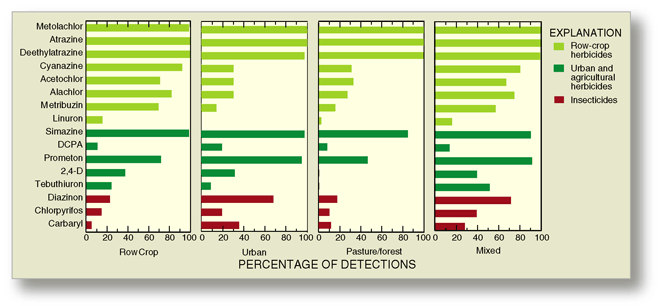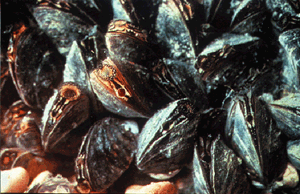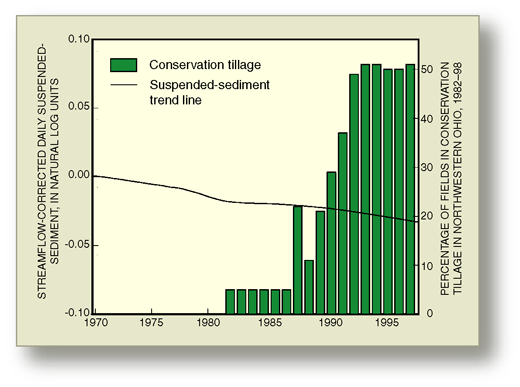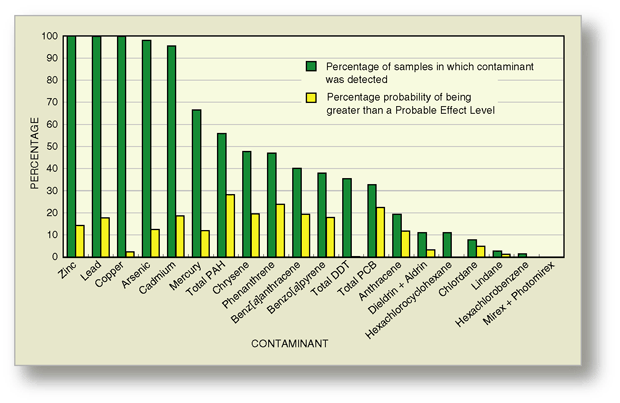MAJOR FINDINGS
The quality of streams and ground water in the Lake Erie-Lake Saint Clair Drainages is affected by a complex combination of natural factors (precipitation, streamflow, geology) and human factors (land use, chemical use, population density). Specific parts of the basin were targeted for investigation because they have particular combinations of natural and human factors. (See Appendix for details.) A primary factor that was found to influence water quality was land use, and this factor is emphasized throughout the report.
Pesticides were detected in every stream sample
Between March 1996 and February 1998, 305 samples were collected from 10 streams in the basin. Every sample contained at least one pesticide, and most contained mixtures of several pesticides. Some samples contained a mixture of 18 pesticide compounds, which is among the highest number of pesticides detected in a sample nationally.
More pesticides were detected in large streams than small streams. Overall, 30 different pesticides were detected within the basin. The number of pesticides detected was greater in large streams and rivers that drain areas of mixed land use (urban and agricultural) than in smaller streams that drain basins dominated by a single land use.
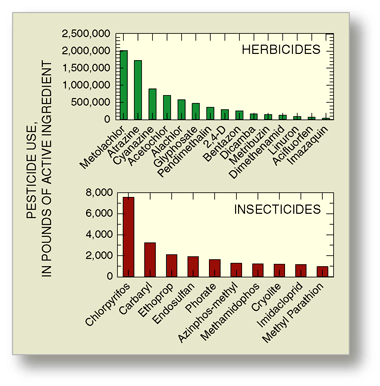 |
| Figure 9. A total of nearly 8.3 million pounds of pesticides was applied in the agricultural areas of the Lake Erie-Lake Saint Clair Drainages during 1994–95. (Data from Brody and others, 1997.) |
The pesticides most frequently detected in streams were generally those most heavily applied
Pesticide applications to crops in the Lake Erie-Lake Saint Clair Drainages are among the highest nationwide. The five most heavily applied agricultural pesticides—metolachlor, atrazine, cyanazine, acetochlor, and alachlor—were also among the most frequently detected (figs. 9 and 10). Atrazine was detected in every stream-water sample collected during 1996–98 (fig. 10). Metolachlor was detected in 99 percent of samples, and simazine was detected in greater than 80 percent of samples, regardless of land use (fig. 10). Two pesticides that are heavily used in the basin were not analyzed for in this study: (1) glyphosate, an herbicide used in agricultural and urban areas, and (2) endosulfan, an organochlorine insecticide, which was analyzed for in streambed sediment but not in water.
|
| Figure 10. Metolachlor, atrazine, deethylatrazine, cyanazine, and simazine were the most frequently detected herbicides. Diazinon, chlorpyrifos, and carbaryl were the most frequently detected insecticides. |
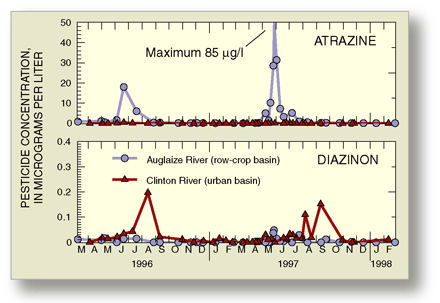 |
| Figure 11. The concentration of atrazine was higher in streams draining row-crops, whereas the concentration of diazinon was higher in streams draining urban-land use. |
Pesticides detected more frequently in urban than in agricultural areas include the herbicide prometon and the insecticides diazinon and chlorpyrifos (figs. 10 and 11). Chlorpyrifos (Dursban), which was detected in 22 percent of the samples, was recently restricted for residential and commercial use by the U.S. Environmental Protection Agency (USEPA).
Historical-use pesticides are seldom detected in water. Aldrin and DDT are organochlorine insecticides banned in the mid-1970s. Their metabolites (dieldrin and DDE) were each detected in about 1 percent of stream samples. In contrast, total DDT was detected in nearly 35 percent of all streambed sediment samples (fig. 19, p. 13).
Pesticide metabolites were frequently detected
Little is known about pesticide metabolites (breakdown products) on a watershed level. After application, most pesticides adsorb to soil, infiltrate to ground water, volatilize, or break down to a metabolite (Larson and others, 1999). Deethylatrazine, a metabolite of atrazine, was detected in every sample collected during 1996–98. Additional triazine and acetanilide herbicides and their metabolites were intensively sampled for at one site, the St. Joseph River near Newville, Ind. Here, the metabolites of triazine compounds, like atrazine, showed the same seasonal pattern and relative concentrations as parent compounds. In contrast, concentrations of the acetanilide parent compounds—alachlor, acetochlor, and metolachlor—were lower than those of their metabolites for most of the year (fig. 12).
No benchmarks for metabolites have been set to protect human health or aquatic life, but some metabolites are believed to be as toxic as parent compounds (Day, 1991). Because metabolites may account for a significant amount of the total pesticides in the environment, they are considered a water-quality concern.
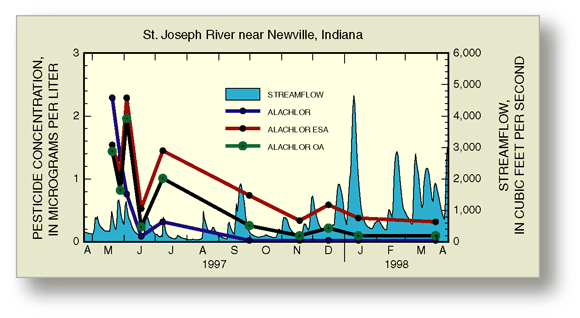 |
| Figure 12. Metabolite concentrations for alachlor, as well as acetochlor and metolachlor (not shown), were greater than parent compounds for much of the year. |
Pesticide concentrations in streams are related to land use, rainfall, runoff, and season
Herbicide concentrations were highest in streams draining row-crops followed by streams draining mixed-use and urban land, and were lowest in streams draining pasture/forested land. Atrazine was detected at the highest concentrations, as high as 85 µg/L (micrograms per liter), in streams draining row crops and at much lower concentrations in streams draining urban land (fig. 11).
Rainfall and runoff affected the concentrations of atrazine in the wet years of 1996–97 compared to the dry year of 1998 in the St. Joseph River near Newville, Ind. (fig. 13). In 1996, streamflow was 330 to 340 percent above average in May and June; in 1997, streamflow was 103 to 129 percent above average in May and June; and in 1998, streamflow was only 36 to 78 percent of the average. The median atrazine concentration detected in the stream was 0.40 µg/L in 1996, 0.45 µg/L in 1997, and 0.14 µg/L in 1998.
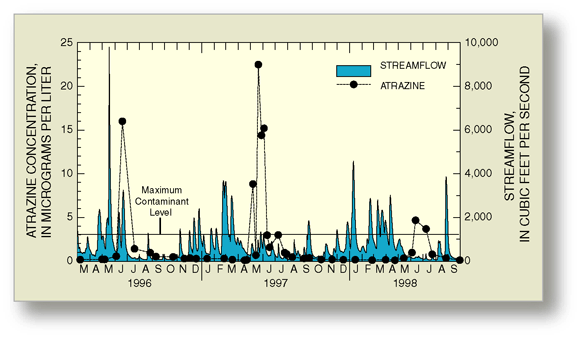 |
| Figure 13. Pesticides such as atrazine show a seasonal trend with streamflow, as shown for the St. Joseph River near Newville, Ind. Differences in the amount and timing of precipitation affect the concentrations, as illustrated by the differences between the wet years of 1996–97 and the dry year of 1998. |
Herbicide concentrations in streams are typically highest after application and steadily decrease thereafter. Elevated concentrations of the most heavily used herbicides—metolachlor, atrazine, cyanazine, and acetochlor—were detected for 4 to 6 weeks after rainfall and runoff in the spring and early summer (fig. 13, table 1). Pesticides used mostly in urban areas, such as prometon and diazinon, are typically applied in late summer, and this is when the highest concentrations were detected in streams (fig. 11).
Pesticide concentrations in streams have public-health and economic consequences
When concentrations of a contaminant in stream water are greater than a Maximum Contaminant Level (MCL), treatment might be needed to reduce the concentration (Box 1).
| Table 1. Annual and seasonal time-weighted average concentrations of atrazine at 10 stream sites in the Lake Erie-Lake Saint Clair Drainages, 1996-98 |
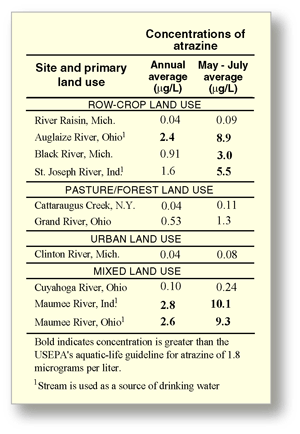 |
The time-weighted average annual concentrations of atrazine were not greater than the drinking-water standard, or MCL, of 3 µg/L at any of the 10 stream sites sampled during 1996–98 (table 1). The values from May–July, however, were greater than the MCL at five stream sites (table 1), indicating a need for source-water treatment during that period to remove the pesticides.
Many large water-treatment facilities that withdraw surface water (other than Lake Erie) use activated-carbon filtration during the spring to meet drinking-water standards. In areas of heavy pesticide use, specialized treatment may be necessary year round. For example, the Fort Wayne Water-Filtration Plant uses activated carbon all year. The annual cost of the treatment chemicals at Fort Wayne is approximately $210,000, about 40 percent of this amount being spent from April to July (Doug Pooler, Fort Wayne Water Filtration Plant, oral commun., 1999). Even with carbon treatment, some treated drinking-water samples tested for atrazine were in excess of the MCL during 1996–98 (Kelleher, 1999).
Another consequence of heavy pesticide use is the
potential effect on aquatic life
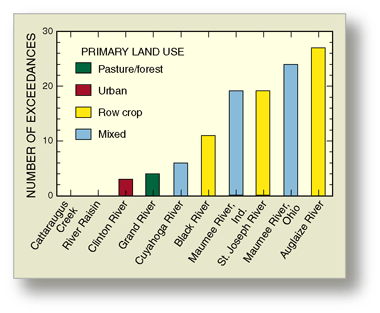 |
| Figure 14. The greatest number of concentrations of pesticides affecting aquatic life were detected in streams draining row crops and mixed-use land. |
Of the 10 streams sampled, 8 had pesticide concentrations, in single samples, in excess of one or more aquatic-life guidelines (fig. 14) (Frey, in press). Concentrations in excess of aquatic-life guidelines were detected for the herbicides atrazine, metolachlor, cyanazine, and metribuzin, and for the insecticides chlorpyrifos, carbaryl, and diazinon. Heavily used compounds—metolachlor, atrazine, cyanazine, and metribuzin—were the compounds with concentrations most frequently greater than guidelines. The time-weighted average concentration of atrazine, for example, was in excess of the 1.8-µg/L guideline at 3 of 10 sites annually and at 5 of 10 sites during May–July (table 1).
| Box 1—What concentrations of pesticides are
considered safe in drinking water? The USEPA sets drinking-water standards, or Maximum Contaminant Levels (MCLs), and health advisory–lifetime quidelines (HALs) for drinking water, to protect human health. The MCL is the maximum permissible concentration of a contaminant in water delivered to any user of public water systems. MCLs are enforceable standards and are based on an average annual concentration taken from quarterly samples of finished drinking water. HA (Health Advisories) are nonenforceable, risk-based guidelines. Health advisories indicate contaminant exposures below which no short- or long-term adverse human-health effects are expected, based on drinking a specific amount of water for a specific period of time. Risk of illness increases with exposure time and concentration. This report lists only HALs, which are based on a lifetime of 70 years. Standards and guidelines to evaluate the potential adverse effects of pesticides have limitations: (1) Few standards and guidelines have been set for pesticides; of the 88 pesticides analyzed in this study, only 14 MCLs and 38 HALs have been established. (2) Drinking-water standards are based on toxicity tests on a single pesticide and do not evaluate the additive or synergistic effects of multiple pesticides. (3) The standards and guidelines do not address possible effects of pesticides on endocrine systems of humans (Nowell and Resek, 1994; Larson and others, 1999). |
| Box 2—What concentrations of pesticides are
considered safe for aquatic life? Several agencies, including the USEPA, Environment Canada, and the IJC (International Joint Commission), have set guidelines to protect aquatic life. These guidelines are designed to prevent adverse short-term (acute) and long-term (chronic) effects on aquatic life. The aquatic-life guidelines or benchmarks developed by USEPA are based on 4-day average concentrations, are intended to protect 95 percent of the aquatic species, and should not be exceeded more than once in 3 years. The Canadian and IJC aquatic-life guidelines, which are more stringent than those of the USEPA, indicate a single maximum concentration that should never be exceeded. Aquatic-life guidelines have been developed for only 18 pesticides. |
Because the amounts of fertilizers and herbicides applied to agricultural areas are among the highest in the Nation, concentrations of nutrients and herbicides in stream water also are comparatively high at 8 of 10 streams sampled during 1996–98. In eight streams draining agricultural and mixed-use land, average annual concentrations of total phosphorus were in excess of the 0.1-mg/L (milligram per liter) guideline recommended by USEPA to reduce stream eutrophication (fig. 15). In four streams, phosphorus concentrations were in the upper 25 percent of all streams sampled nationwide by NAWQA, as were nitrate concentrations in six streams. In two streams that serve as source waters for public supply, nitrate concentrations in a few samples were detected in excess of the drinking-water standard. Although total phosphorus concentrations appear to be relatively high, the work of other investigators has shown that concentrations of total phosphorus were 40 percent lower in 1995 than in 1976 (Baker and others, 1998). In two of the streams where nutrient concentrations were in the upper 25 percent range on a national basis, average annual concentrations of herbicides were in the upper 25 percent as well. Mixtures of pesticide compounds were found in every stream sample and a total of 30 different pesticides were detected. In one sample, 18 different pesticides were detected. This sample contained more pesticide compounds than 98.5 percent of all the samples collected at 343 sites across the Nation during 1993–98. |
Runoff from agricultural land to streams is an important pathway of phosphorus to Lake Erie
In the 1960s, Lake Erie was considered “dead” from the
excessive growth and decay of algae and the oxygen-depleting effects of
this decay on the bottom water of the lake (Herdendorf, 1986). By 1971,
it was well known that the major sources of phosphorus to the lake were
sewage, laundry detergents, and fertilizers. The Great Lakes Water-Quality
Agreement (International Joint Commission, 1994) set goals for United
States and Canada to reduce phosphorus inputs to the lake. Actions taken
to reduce phosphorus included a limit on the phosphorus content of detergents,
a limit of 1.0 mg/L in discharges from sewage-treatment plants, and a
total load limit for Lake Erie of 11,000 metric tons per year (International
Joint Commission, 1994). Having achieved the point-source reductions over
the period 1968–92 (Litke, 1999), the focus shifted to reducing nonpoint
sources of phosphorus.
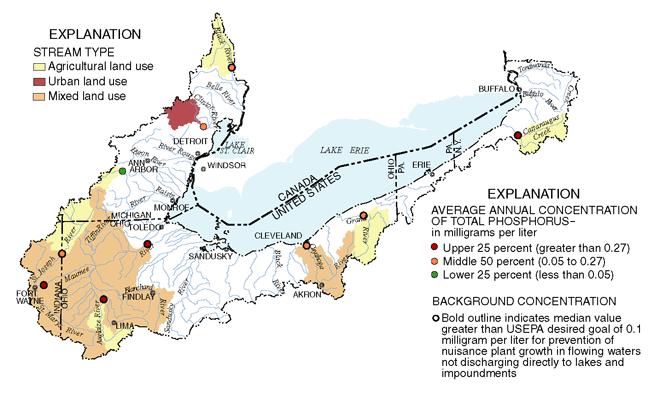 |
| Figure 15. Median concentrations of total phosphorus at 8 of 10 sites in the Lake Erie–Lake Saint Clair Drainages were in excess of 0.1 milligram per liter, the USEPA guideline to control eutrophication in streams. |
A sustained focus on reducing nonpoint sources of phosphorus to Lake Erie has continued because oxygen depletion in the bottom water in some areas occurs intermittently (Bertram, 1993; Litke, 1999). One reason may be that in years with above-average runoff, annual phosphorus loads to the lake exceed 11,000 metric tons (Dolan, 1993). The excess phosphorus in wet years is thought to come from nonpoint sources (Dolan, 1993).
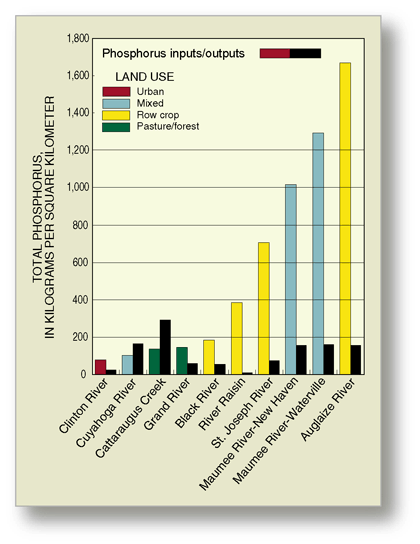 |
| Figure 16. Unit-area phosphorus inputs to the land surface from fertilizer and manure and unit-area phosphorus outputs from 10 streams in the Lake Erie-Lake Saint Clair Drainages, 1996–98. |
Fertilizers appear to be the major nonpoint sources of phosphorus to Lake Erie. Greater amounts of phosphorus were applied as fertilizers to each square kilometer of agricultural and mixed-use land than to urban-residential land in 1996–98 (fig. 16). Phosphorus yields, or the amount of phosphorus discharged from a stream per unit area of its basin, ranged from 8.2 to 293 kg/km2 (kilograms per square kilometer). The phosphorus yield from only 1 of 10 streams sampled during 1996–98 was in the lower range of yields typical of streams flowing through undeveloped land (Clark and others, 2000).
Phosphorus yields in eight streams were similar to or slightly higher than the yields typical of streams flowing through agricultural and mixed-use lands (Gibson and others, 2000). Phosphorus concentrations were highest in the same streams where yields were highest. Therefore, streams receiving runoff from agricultural and mixed-use lands contributed greater concentrations and amounts of phosphorus to Lake Erie than did streams receiving runoff from urban-residential land (fig. 16). A conclusion is that agricultural runoff is an important nonpoint source of phosphorus to small streams and major rivers and that major rivers, like the Maumee River, provide a direct pathway to Lake Erie. During 1996–98, the Maumee River contributed an average of 24 percent per year to the 11,000-metric-ton limit.
In the last few years, phosphorus concentrations in
Lake Erie appear to be increasing above levels recommended in the Great
Lakes Water-Quality Agreement (Scott Painter, Environment Canada, written
commun., Oct. 2000). Continued emphasis on managing levels of phosphorus
in Lake Erie appears to be warranted (Box 3).
Box 3—Recent changes in the food web of Lake Erie-the role of phosphorus and zebra mussels
Concerns about recent declines in some important fish species and the proliferation of zebra mussels, an exotic species, have prompted a renewed interest in the role of phosphorus in Lake Erie. Zebra mussels (shown in the photograph) were introduced into Lake Saint Clair in the mid-1980s and quickly became established in Lake Erie. Because of their filter-feeding behavior, zebra mussels may be affecting fish production in Lake Erie by consuming large amounts of small invertebrates and algae, or plankton, that are the food for small fish, which in turn are the food of larger game fish like yellow perch and walleye. Recent decreases in sport- and commercial-fish harvests, proliferation of zebra mussels, and reductions in phosphorus concentrations in Lake Erie have prompted a renewed interest in how factors such as phosphorus and zebra mussels may be affecting sustainable fish harvests. Adding more phosphorus to the lake to stimulate algal productivity has been suggested, but this could result in increased eutrophication of tributary streams and a return to excessive oxygen depletion in the bottom water of the lake. Furthermore, uncertainties about the response of the lake to phosphorus additions in light of its changing food web have held back plans to apply such a solution. One thing about which everyone can agree is the remarkable ability of exotic species to cause unexpected consequences in ecosystems (U.S. Environmental Protection Agency and Environment Canada, 2000). |
Decreases in the amounts of suspended sediment carried by rivers correspond to increases in farmers’ use of conservation tillage
Cropland in the Maumee River Basin is the largest contributor to soil erosion and sediment in the Maumee River (U.S. Department of Agriculture, 1998), and the river is the largest tributary source of suspended sediments to Lake Erie (Myers and others, 2000). Excessive amounts of sediment discharged from the Maumee River to Lake Erie diminishes the aquatic habitats of fish and other organisms. Maintenance of navigation requires the dredging of approximately 800,000 tons of sediment each year from the Maumee River and Lake Erie at an average annual cost of about $2.2 million. In response to these problems, the Ohio Lake Erie Commission has set a goal of reducing suspended sediment in Lake Erie tributaries by 67 percent (Ohio Lake Erie Commission, 1998), and the U.S. Army Corps of Engineers has set a goal of reducing the amount of sediment dredged from the lower river and its harbor by 15 percent.
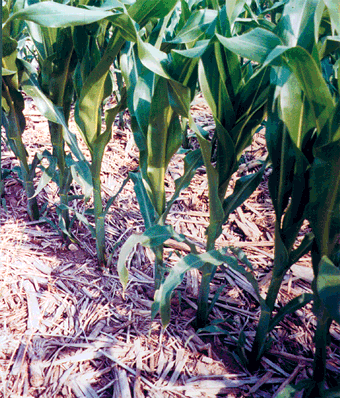 |
|
| Figure 17. Conservation tillage protects the soil. (Photograph by Steven Davis, Natural Resources Conservation Service). |
Conservation tillage (fig. 17) is a reduced-cultivation method that is being used to decrease soil erosion and thereby the amount of suspended sediment carried by the Maumee River and its tributaries. By maintaining a layer of crop residue from the past year’s crop on 30 percent or more of the soil surface, conservation tillage protects the soil from the forces of water erosion. During 1993–98, about 53 percent of all crop fields in the Maumee River Basin and about 50 percent of the crop fields in northwestern Ohio were planted using conservation tillage methods (fig. 18).
Significant decreases in the amounts of suspended sediment carried by the Maumee and Auglaize Rivers over time correspond to increases in conservation tillage. Data from previous studies and new data collected at two sites in the Maumee River Basin during 1996–98 support this conclusion (Myers and others, 2000). An 11.2-percent decrease in the amount of suspended sediment carried by the Maumee River was detected at Waterville, Ohio, near the mouth (fig. 18), and a 49.8-percent decrease was detected in the amount carried by the Auglaize River near Fort Jennings, Ohio, a tributary stream (Myers and others, 2000). During 1970–98, no trends in streamflow at these two sites were detected. If conditions leading to the downward trends remain the same, then the estimated time necessary to achieve the 15 and 67 percent reduction goals are 30.1 and 205 years, respectively, from the reference condition in 1992.
| Figure 18. Increases in conservation tillage in the Maumee River Basin and elsewhere in northwestern Ohio correspond to decreases in the amount of suspended-sediment carried by the Maumee River at Waterville, Ohio. |
One reason for the smaller downward trend in the Maumee River compared to that found in its tributary may be related to drainage-basin size. In the large drainage basin of the Maumee River, sediment is deposited in small drainage ditches and streams. These stored sediments are available for resuspension and transport in subsequent storms.This process, as described by Trimble (1975, 1999), creates a lag in the response of rivers to conservation tillage on the land.
Contamination of bed sediments may be causing adverse effects on aquatic life
Bed sediments of small streams and major rivers provide habitat for many aquatic organisms but also serve as a repository for persistent and toxic chemical contaminants that have been released into the environment or that occur naturally. Sediments, once contaminated, can provide a pathway for bioaccumulation. Activities such as dredging of sediments can release contaminants to the surrounding water.
Evidence from laboratory tests shows that contaminated bed sediments can be toxic to aquatic invertebrates (worms, clams, and insect larvae) that are of recreational, commercial, or ecological importance. Contaminated sediments also can affect the food supply required to sustain fish populations (U.S. Environmental Protection Agency, 1997).
Data collected by the U.S. Geological Survey (USGS) and other public-sector agencies at more than 800 locations from 1990 to 1997 were aggregated and analyzed to assess bed-sediment contamination. These data show that zinc, lead, copper, arsenic, cadmium, mercury, PAHs (polycyclic aromatic hydrocarbons), PCBs (total polychlorinated biphenyls), DDT, and its breakdown products are prevalent in bed sediments, being detected in 30 to 100 percent of samples (Rheaume and others, in press) (fig. 19).
| Figure 19. Percentage detection and percentage probability of sample concentrations being greater than a Probable Effect Level in bed sediments of small streams, major rivers, and lakes, Lake Erie-Lake Saint Clair Drainages, 1990–97. |
Concentrations of mercury and PCBs (figs. 20 and 21) exceeded Probable Effect Levels (PELs) in 11.8 and 22.4 percent of samples, respectively. PELs are the guidelines established for the protection of aquatic life (Box 4). Contamination of bed sediments with mercury and PCBs was greatest in nearshore areas of Lake Erie, in Lake Saint Clair, and in major rivers that flow through urban areas with industry and populations over 100,000.
| Box 4—How are contaminated sediments
evaluated? |
Concentrations of arsenic, DDT, and chlordane also exceeded PELs in the bed sediments of some smaller streams. Samples with detection limits higher than Threshold Effect Levels (TELs) (open circles, figs. 20 and 21) were not useful for assessment purposes. Lower detection limits would have made these data more useful.
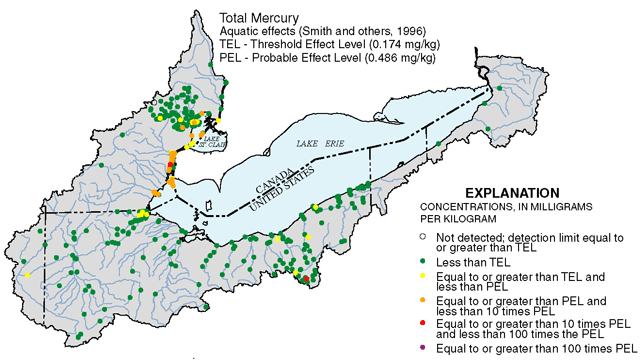 |
| Figure 20. Concentrations of total mercury in recently deposited lakebed and streambed sediments (Data from 1990-97). |
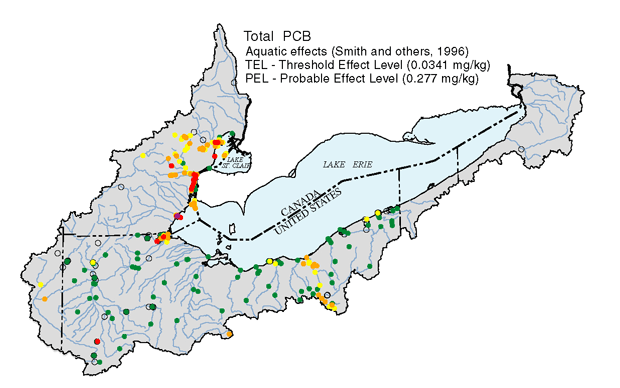 |
| Figure 21. Concentration of total PCB in recently deposited lakebed and streambed sediments (Data 1990-97). |
Land use and chemical use contribute to contamination of sediments and fish
Most organochlorine pesticides and PCBs have not been manufactured or used in the United States for at least 10–25 years; however, because of their chemical stability (persistence), they were detected in bed sediments and fish collected in 1996–98. Aldrin, DDT, and chlordane were the organochlorine insecticides used in the greatest quantities in the Corn Belt and Great Lakes States in the 1970s. Similarly, historical use of PCBs in industry contributed to their occurrence in urban and mixed-use areas.
The highest concentrations of DDT, chlordane, dieldrin, and their breakdown products were detected in bed sediments and fish collected from small streams and major rivers flowing through row-crop, urban, and mixed-use lands. The highest concentrations of PCBs, DDT, and chlordane were detected in bed sediments and fish from streams flowing through urban and mixed-use lands where historical use was greatest. Organochlorine contamination was the lowest in fish and sediments collected from streams in pasture/forest settings.
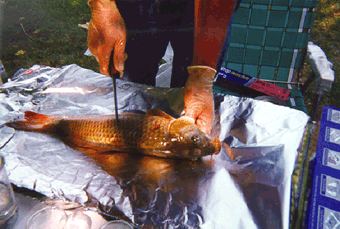 |
| Figure 22. Total chlordane, total DDT, dieldrin, heptachlor epoxide, mercury, and total PCBs were detected in the tissues of carp, rock bass, and northern hog suckers collected in 1996–97. |
Unlike organochlorine compounds, mercury has more than 2,000 uses in industry, medicine, agriculture, and commerce. Mercury also is released to the atmosphere as a by-product of coal combustion and waste incineration (Irwin and others, 1997). In 1996–97, mercury was detected in all 15 bed-sediment samples and in all 11 fish-liver samples collected from streams, independent of land-use type. The highest concentrations of mercury, however, were detected in bed sediments and fish collected from small streams and major rivers that flow through urban and mixed-use lands. The magnitude of mercury contamination in bed sediments and fish appears to follow patterns of use in commerce and industry. Mercury was detected in several different fish species that have different feeding habits and that occupy different positions in the food web. Mercury was detected in carp, which are bottom-feeders, in northern hog suckers, which eat insects, and in rock bass, which eat smaller fish (fig. 22).
| Table of Contents || Previous Section || Next Section || Glossary U.S. Geological Survey Circular 1203 Suggested citation:
|

